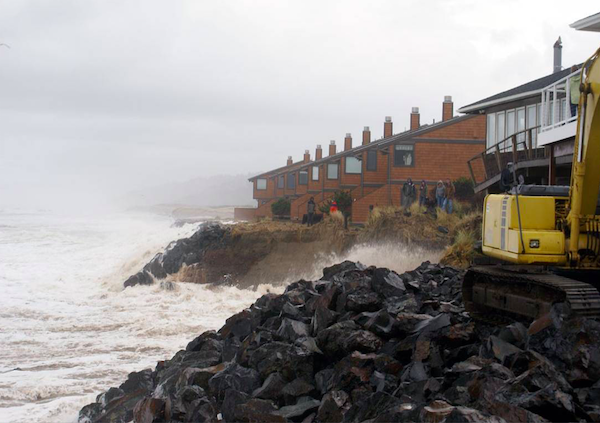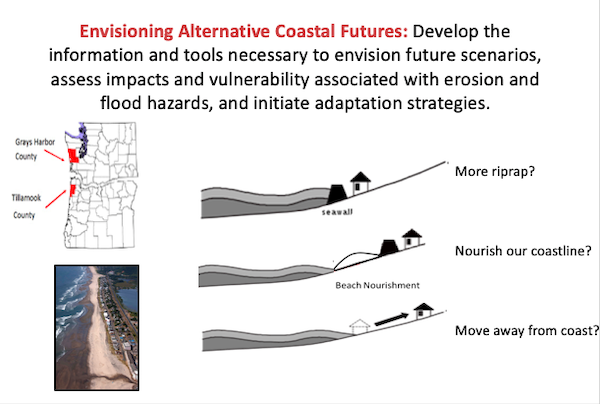
Imagine 50 years from now the Oregon coast, armored with rip rap and seawalls, lined with condominiums and fee-only beach access points. Parking is at a premium and the "birthright" that is Oregon's beaches is only accessible and walkable at low tides. While this likely isn't the Oregon coast most of us envision, it very well could be if we don't take our heads out of the sand and plan for our future coastal living with the latest climate, social and economic science. And that's exactly where a new project from Oregon State University and Oregon Sea Grant comes in, Oregon Coastal Futures, to examine the effect that various coastal shoreline adaptation and mitigation measures have on coastal communities resilience to chronic and acute hazards such as coastal erosion, flooding and earthquake/tsunamis. The project will use the latest science to provide communities and stakeholders with various future scenarios, allowing us to see the future impacts of decisions we make today.
 Home and condo owners respond with armoring in the wake of the 2008 winter storms that rocked the Oregon coastline. Photo: Oregon Sea Grant
Home and condo owners respond with armoring in the wake of the 2008 winter storms that rocked the Oregon coastline. Photo: Oregon Sea Grant
Last week I sat in a meeting, where a lawyer representing 15 ocean-front condominium owners wagged her finger at me and state agency representatives, threatening Oregon's Beach Bill with a Supreme Court challenge. I don't expect her or the condo-owners that hired her had a clue when they invested in their property that it was subject to heavy erosion and not eligible for shoreline hardening or rip rap protection. Had they known, they probably wouldn't have bought in the area. That foresight would have prevented these condo owners now nearly half million dollars in "soft hardening" protection measures, that are ultimately failing them in protection from the coastal erosion. Further, that foresight wouldn't have left me (and many others) in a room, with an emotionally-charged lawyer throwing private property right threats like hand grenades at Oregon's most treasured public resource. Using tools such as those utilized in the Coastal Futures project, we can make well-informed decisions about responding to coastal hazards we face like shoreline erosion and sea level rise, before the hazard (and emotion) are upon us.
 Pending how we respond to coastal erosion can have big impacts on beach accessibility. The above models a stretch of Oregon beach's accessibility under various shoreline protection responses.
Pending how we respond to coastal erosion can have big impacts on beach accessibility. The above models a stretch of Oregon beach's accessibility under various shoreline protection responses.
Climate change is exacerbating both the chronic (sea level rise/storms) and acute (earthquake/tsunami) naturally occurring hazards of coastal communities. Generally speaking, we don't refer to these events and phenomenon as hazards except for when humans are in the way, but one thing is for sure, we humans are finding ourselves more and more in the way of these "hazards" due to climate change. We have two ways we can respond to these hazards: 1) through preventative measures and strategies before we are immediately facing the hazards, or 2) through reactive measures that occur after the hazard is well upon us. The Coastal Futures project is an investment in the first strategy to better plan for and understand the tradeoffs of our actions to mitigate and adapt to increased hazards. As an ounce of prevention is worth a pound of cure, recent studies have demonstrated that at the national level, an average of $6 can be saved for every $1 spent on preventative measures and planning strategies that minimize impact vs those spent responding to hazards.
 3 types of scenarios the Envision model explored in previous projects for the communities of Tillamook and Grays Harbor
3 types of scenarios the Envision model explored in previous projects for the communities of Tillamook and Grays Harbor
The state of Oregon is susceptible to sea level rise, increased coastal storms and wave-height, coastal erosion and the rupture of the Cascadia Subduction Zone leading to an earthquake/tsunami - one of the most extreme acute coastal hazards in the world. This made Oregon the ideal setting for the coast-wide Oregon Coastal Futures project that will span a 3.5 year investigation for coastal hazard planning. Surfrider Foundation is plays a role on the project's Advisory Committee that meets semi-annually.
The Oregon Coastal Futures Project is funded by Oregon Sea Grant through their SEED to LEAF program (designed to support large-scale, cutting-edge, interdisciplinary research relevant to important marine or coastal issues). It draws on over four years of engagement with local stakeholders (decision-makers, outreach specialists, community leaders) on projects in Tillamook County, OR and Grays Harbor, WA where many of the Envisioning Coastal Futures models were first utilized. This approach includes:
Co-production of coastal policies and resilience goals
Modeling of differing policies with chronic coastal hazards (flooding and erosion)
Exploration of trade-offs of different policies
Development of ideal scenarios/ pathways
While successful, these projects identified gaps in previous studies. The current Oregon Coastal Futures Project, beyond expanding analysis to the entire Oregon Coast, has added several components that will enhance our understanding of Oregon's vulnerabilities and inform future resilience planning that (hopefully) supports our interests in coastal preservation.
Acute Hazards
(earthquakes and tsunamis associated with the Cascadia Subduction Zone)
Econometric Models
(housing value responses to hazard mitigation and factors leading to coastal land use change)
Socio-Economic Vulnerability
(metrics that measure community equity and well-being; qualitative interviews and participatory mapping of community priorities and preparedness)
 The various data and informational components of the Envision model and scenario outputs and resilience metrics.
The various data and informational components of the Envision model and scenario outputs and resilience metrics.
This project is operating on a three and a half year timescale and meets semi-annually with an Advisory Council to ensure that results answer community-defined questions and are usable by advocacy, government, and industry professionals. Surfrider Foundation is excited to participate and support the work of this project as it relates to our efforts to best inform coastal preservation policies in Oregon - stay tuned and visit the project's website to learn more! Also visit Surfrider's climate change website and our activist toolkit.
